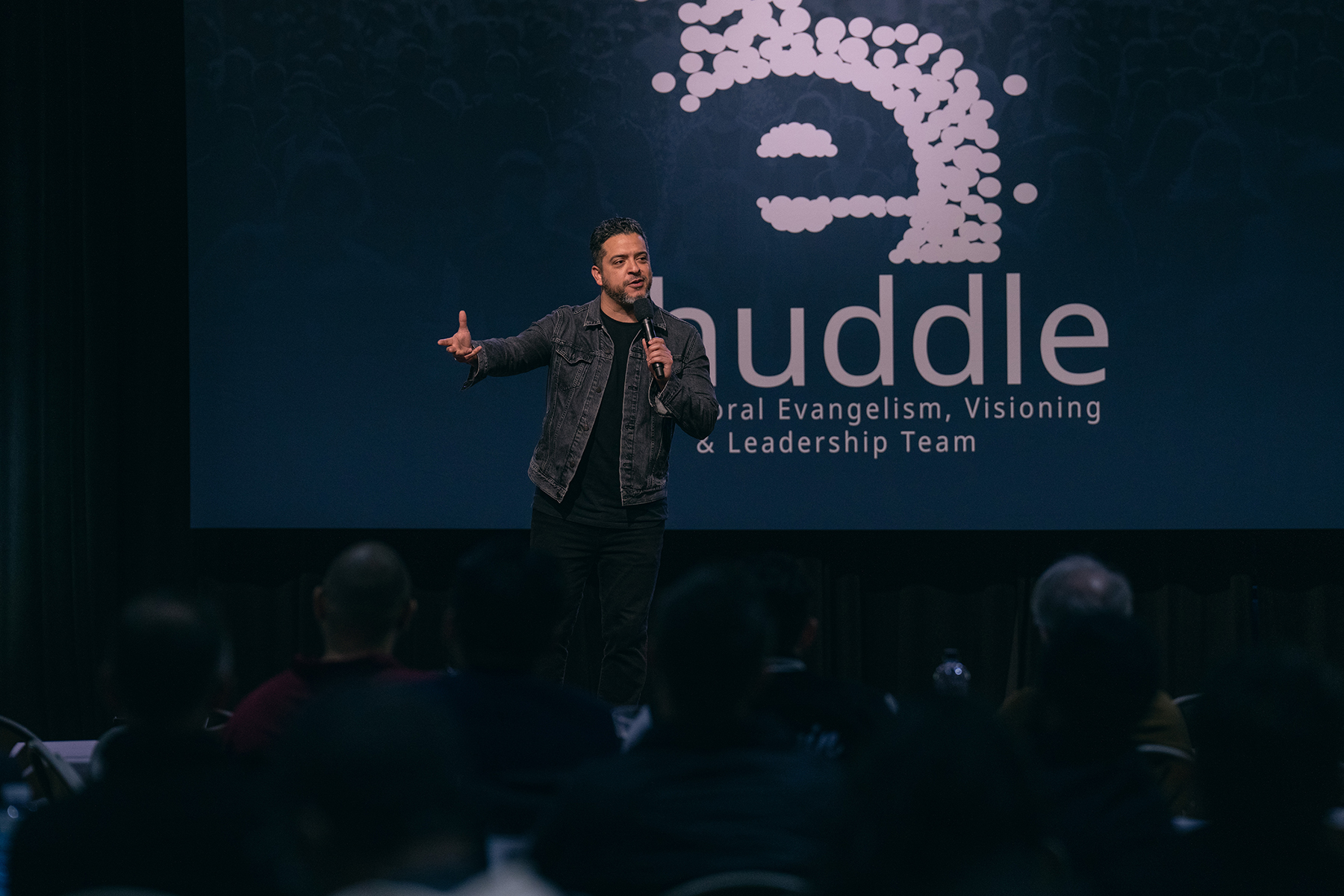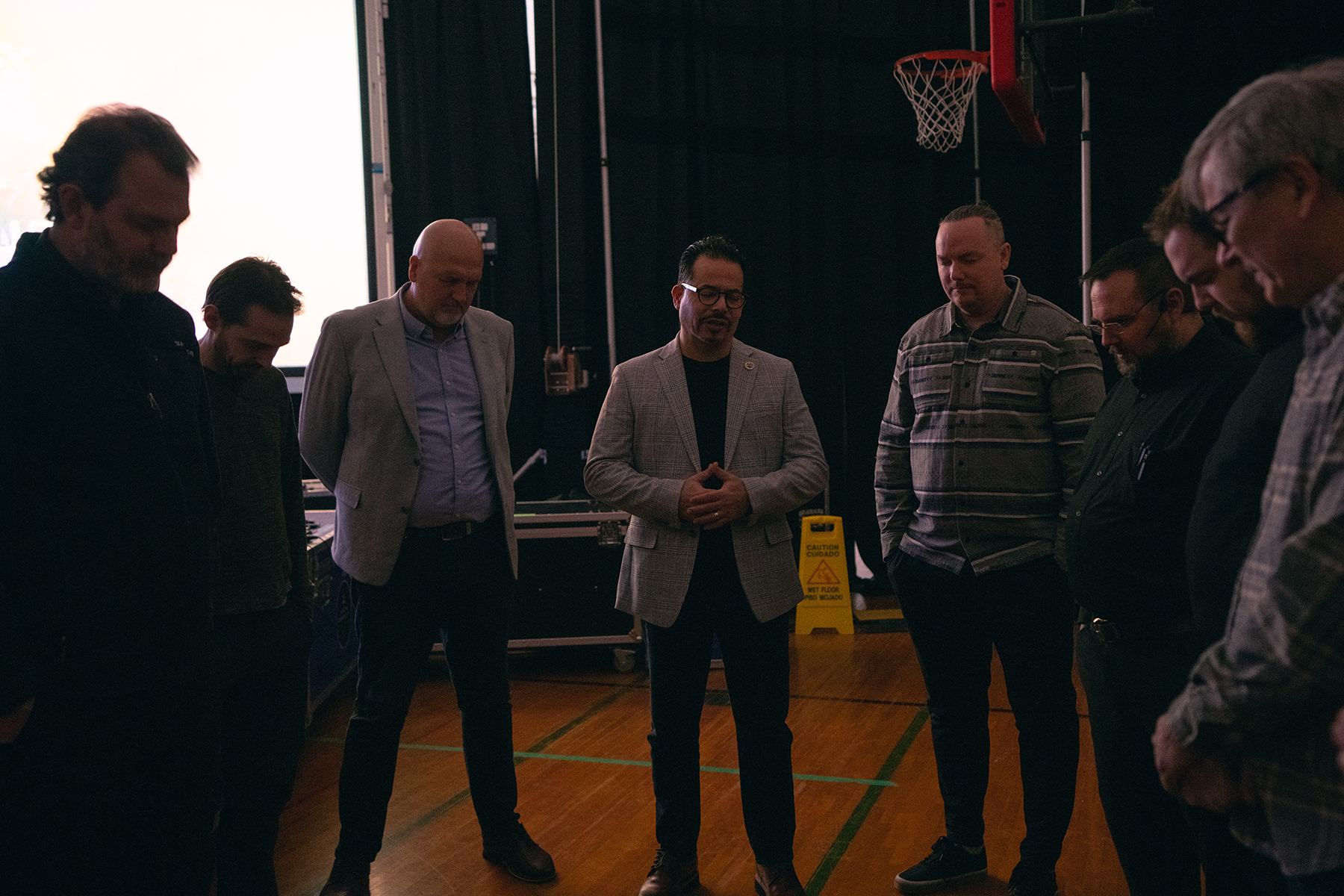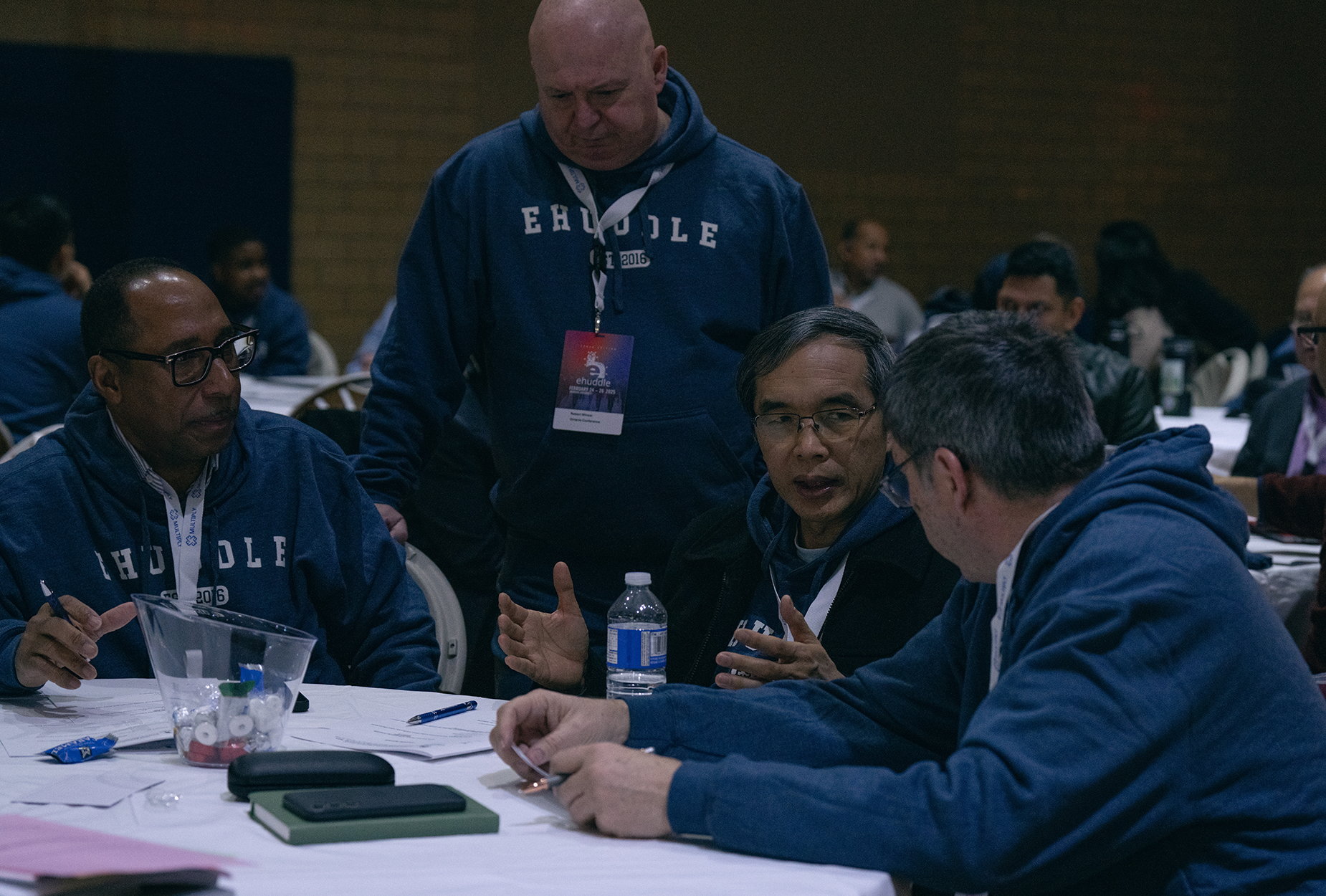
Manny Arteaga, pastor of White Memorial Seventh-day Adventist Church in Los Angeles, California, shares how his church stepped in to assist those affected by the Los Angeles wildfires in January. Photo: Pieter Damsteegt | North American Division
For years, White Memorial Seventh-day Adventist Church in Los Angeles, California, was viewed as the church that did not care. “We see you every Sabbath with your suits and high heels, big Bibles under your arm. But we know that although you’re here, you’re not part of us,” a city council representative told the church’s new pastor, Manny Arteaga.
In January 2025, everything changed.
On Tuesday, January 7, during a vision-setting week of prayer, Arteaga and his leaders experienced three blackouts from heavy winds. The next morning, they awoke to “images that the city we love, our mission field, our home, was on fire,” Arteaga shared at the 2025 eHuddle — an evangelism and leadership think tank hosted by the North American Division (NAD) Ministerial Association from Feb. 24 to 26 at Andrews University in Berrien Springs, Michigan.
More than 400 leaders, theology and seminary students, and faculty listened intently as the story unfolded. As wildfires swept Los Angeles, forcing evacuations, two members sought refuge at White Memorial. With no plan in place, leaders opened their doors to evacuees. Prayer meetings continued, a constant plea on their lips: God, use us and amaze us. And He did.
A small table of water and snacks quickly became a “Costco” of supplies, bolstered by donations from the Chamber of Commerce, American Red Cross, Buddhist monks, Freemasons, and others. Situated between the fire-ravaged areas of Palisades and Altadena, the church became, and remains, a haven for the most vulnerable — housekeepers, landscapers, nannies, and others who lost their livelihoods. For the first time, the church and community pressed together.

Leaders, theology and seminary students, and faculty gather at the 2025 eHuddle to celebrate and share powerful testimonies of God’s work in churches and communities across North America. Photo: Pieter Damsteegt | North American Division
An emotional Arteaga shared a story of his 14-year-old daughter walking through “Costco” in tears, saying, “Dad, I just cannot believe this is our church.” Her statement reflected the deep impact of White Memorial’s ministry of service. Arteaga noted that these efforts have helped build trust with families navigating fear and uncertainty due to immigration enforcement, transforming the church’s role in the community. He concluded, “It is my hope and prayer that your children, your grandchildren, can say the same about your [church].”
This was one of many powerful testimonies shared at the 10th annual eHuddle, held in English on Feb. 24 and 25, and in Spanish on Feb. 26, reaching thousands viaFacebook and YouTube. Online viewers also enjoyed a behind-the-scenes Q&A with all speakers.
Best Practices Across North America
With the NAD’s Pentecost 2025 initiative — calling for at least 3,000 proclamation efforts — underway, presentations, panels, and discussions emphasized the vital role of the Holy Spirit in evangelism. Paulo Macena, NAD leadership director, described the Spirit as “The Hidden Power,” citing Zechariah 4:6: “Not by might, nor by power, but by my Spirit, says the Lord Almighty” (KJV). Each session also reflected the NAD’s definition of evangelism and its seven key actions: love, pray, serve, baptize, equip, plant, and revitalize.
Bob Winsor, pastor of Nepean Seventh-day Adventist Church in Ontario, Canada, was among the speakers sharing the secrets to a Spirit-led church transformation. When he started at Nepean, it had plateaued at 100 members, was monocultural, and had a median age of 55. Today, it boasts 250 to 300 weekly visitors from 47 cultures, with 70 percent of members under age 45. Winsor attributed this growth to prayerfully setting a compelling vision and mission, meeting people’s needs for belonging, and involving members in relevant community outreach.
Several other best practices emerged across North America, including:
Discipling Children and Youth

Krysten Thomas, children and youth pastor at Beltsville Adventist Church, shares how she and other local pastors are discipling young people at Beltsville Adventist School. Photo: Pieter Damsteegt | North American Division
Krysten Thomas, children and youth pastor at Beltsville Adventist Church, discussed how discipleship is fostered at Beltsville Adventist School, including weekly chapels and Bible studies. She also described how she draws on her technology background to assist the robotics club — a unique venture where student chaplains connect Bible verses to robotics and pray for their team before each practice. “Young people are disciple-makers as well. You don’t have to be an adult [or] a pastor,” Thomas said. “My challenge for us all is to invest in the young people who are not the leaders of the future but are the leaders right now.”
Thomas, a first-time attendee, later reflected, “It was an awesome experience to connect with pastors and ministry leaders from different contexts. I also enjoyed sharing what God is doing with the students at Beltsville. I left feeling refreshed and inspired with new ideas.”
Empowering Lay Leadership
Danny Salcedo, one of the NAD’s volunteer lay pastors (VLPs), shared how White Rock Lake Adventist Church — once on the brink of closure — was revitalized through prayer, members’ support, and structured systems. Attendees also heard from Ron and Donna Wiley, whose spiritual journey led them to start a small group in his dental clinic, eventually securing a school building as the group outgrew the clinic. They have been blessed to witness more than 200 baptisms in over 30 years of ministry. "Start where you are, with what you have, with who you have, and God will take you from there,” Donna concluded.
Combining Compassion and Evangelism
Daniel Hall, pastor of Ephesus Church in Columbia, South Carolina, Gamaliel Feliciano, pastor of Su Casa Church in Collegedale, Tennessee, and Day Fernandez, pastor of Valdosta Park Avenue Seventh-day Adventist Church, described how combining traditional evangelism with giveaways and acts of compassion resulted in significant growth. Fernandez said, “Meeting people's immediate, tangible needs is the gateway to planting the seed of the gospel.” Hall cautioned that the Seventh-day Adventist Church had a responsibility “to not only serve people” but also to “[share] the three angels’ messages [with] people who are dying.”
Building Community
Among the speakers addressing building community was Cristina Macena, director of the Urban Life Center in Baltimore, Maryland, a juice bar and wellness education center, whose team’s responsiveness to community needs has created a thriving center of influence and bridge to a church plant. Juliana Marston, a VLP in Lakewood, New Jersey, shared how starting a needs-based ministry for single mothers in a predominantly Jewish community led to the thriving church plant Grace Place Church and, later, New Birth Church.

NAD production team members, pastors, and leaders pray together during the 2025 eHuddle. Pictured at center are Gerardo Oudri, associate director for resources, Ministerial Association; Jose Cortes Jr., organizer and associate director, Ministerial Association; and Mathew Feeley, pastor of New Life Seventh-day Adventist Church in Oshawa, Ontario, Canada, who conducted Q&As with speakers for online viewers. Photo: Pieter Damsteegt | North American Division
Other presentations encompassed the power of digital evangelism, church planting and revitalization strategies, and practical tips for assisting members with immigration issues from Adventist immigration attorney Katherine Canto.
Defining Our Church’s Reality
On day one, Jose Cortes Jr., eHuddle organizer and NAD Ministerial Association associate director, highlighted the NAD’s scope, noting its nearly 1.3 million members in the U.S., Canada, Bermuda, and Guam-Micronesia, with close to 7,000 congregations, up from 5,500 a few years ago. He credited the Holy Spirit, the NAD’s 4,300 pastors, 22,000 elders, and 600 VLPs for this growth, sharing that post-pandemic, “the North American church has been revitalized, and more people are being reached for Jesus.”
Attendees later learned from Brian Ford, director of eAdventist, that “things are trending in the right direction,” and we are almost back at record 2010 growth levels.
However, Cortes noted that of the 154,000 people who joined the church since 2020, only 90,000 remain. He also referenced research showing that 91 percent of those who left would return if someone reached out to them — a simple act often overlooked. “Even though we’re doing OK, we could be doing better. That’s why we’re here.”

Katherine Canto, immigration lawyer, shares how the church can serve as a refuge for some of the most vulnerable. Photo: Pieter Damsteegt | North American Division
In the final presentation, titled "Immigration Enforcement: What Churches Need to Know,” Canto reinforced Arteaga’s message about the vital role churches across North America play as places of refuge and community allies. Canto positioned the support of immigrant communities as a powerful tool for evangelism. She noted the fear that many immigrants — particularly the undocumented — face, and she stressed the importance of educating them on their rights.
From Canto, attendees learned that the three groups targeted for deportation are individuals with a criminal conviction; individuals with an order of removal; and individuals who have arrived in the past two years. Immigrants outside those groups should not be at high risk of detention or arrest. She also shared that churches are considered private property, and immigration agents should not enter without a judicial warrant for arrest. Finally, Canto offered strategies for dealing with immigration agents regardless of status and recommended that churches host workshops or events with immigration attorneys to educate the community.
Canto underscored, “Churches are a safe space, both spiritually and physically, for those who are vulnerable. And God has given us an opportunity to be His hands and feet in serving the immigrant community.” She added, “We are not a people of fear; we are a people of hope.”
Cortes concluded by reminding attendees of the bigger picture. “The final sign of the Second Coming of Jesus is the proclamation of the gospel.” Referencing Acts 1:8, he said, “When we get the Holy Spirit, we are called to be witnesses of Jesus in Jerusalem … and in the United States, in Canada, in Bermuda, in Guam-Micronesia, and to the ends of the earth.”

Pastors and conference leaders from the Ontario Conference in Canada discuss how they can implement the strategies shared during the eHuddle in their ministry context. Photo by Pieter Damsteegt /North American Division
Rewatch Links
~Monday, February 24
Morning Session: Watch on YouTube
Afternoon Session: Watch on YouTube
~Tuesday, February 25
Morning Session: Watch on YouTube
Afternoon Session: Watch on YouTube
~Wednesday, February 26 (Spanish)
Morning Session: Watch on YouTube
Afternoon Session: Watch on YouTube
Resources: Guidance on Immigration Enforcement Activity
English: Download PDF
Spanish: Download PDF
French: Download PDF
